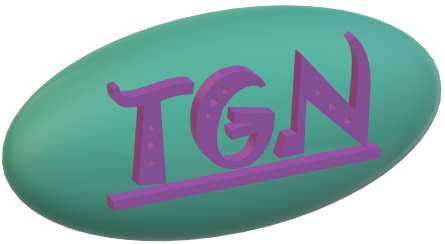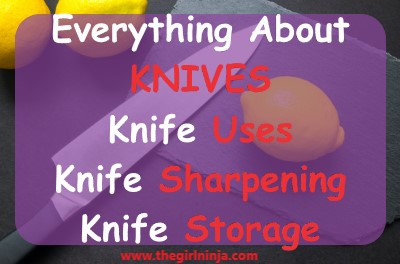Sharpen Your Knife Wits, Know Which Knife is for What
What Knife Do I Need?
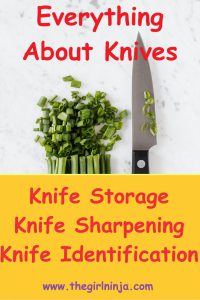
Have you ever prepared a meal and wondered why is it so hard for me to cut this? I have loads of times. That question is very common, and there are two explanations that are most likely the answer to why it is so hard for you to cut something with your knife. The answer is you are either using the wrong knife or your knife needs to be sharpened. Now of course there is always the possibility that you have a crappy knife and should buy a new one.
Chances are though, you just need to change the knife out for the right knife for the activity you are doing or your knife needs to be sharpened. Here we provide a description of the 27 most common knives used in everyday kitchens so you can find the right knife. Below you can find knives broken down by category and listed with a brief description of what the knife looks like and is used for, along with Amazon affiliate links to most of the listed knives for an quick and easy purchase if needed.
If you aren’t looking for any one particular knife at the moment, and are in need of a go to set that will fit all your needs you can consider the following sets ranging in price from $59.98 to $399.97. The range in price is correlated to the material the knife is made out of and how long the knives will last you for, all sets are good options to cover the majority of your knife needs. The quality and life of the knife will heavily depend on your personal budget. At the end of the day we look at knife purchases like investments, they are an item we will use regularly in our home for personal meals as well as meals that bring us together with family and friends.
Marco Almond Kitchen Knife Set (14Piece) Emojoy Knife Set (18Piece) Calphalon Classic Self-Sharpening Knife Block Set (15Piece)
Dalstrong Knife Block Set-Gladiator Series (18Piece)
What’s This Knife For? Identify Which Knife Is For What
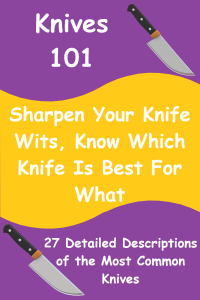
Meat Knives
A knife between 5-7 inches with a thin, flexible, and curved blade that is designed to get in small spaces like between a bone and meat or for butterflying a piece of meat
A thick heavy set knife with a sharp beveled edge good for trimming large cuts of meat or large fruits like melons
A knife that has an 8-15 inch long blade used for slicing or carving a turkey, chicken, or ham
A knife with a thin, long, sharp, non-serrated blade especially used for cutting very thin slices of Spanish cured ham
A knife with an incredibly sharp durable serrated blade used at the table to cut through steak and other meats
Specialty Knives
A long blade with serrated edges, it’s grooves let it slice cleanly through bread without crushing the bread
A knife with a slightly serrated blade and curved tip that is used for butter
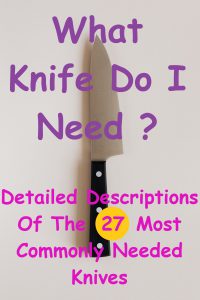
This knife has a blade with perforated holes that prevent cheeses from sticking, good for most cheese but best on dense, sticky, and/or soft cheese. Some cheese knives come with prongs at the tip to use for serving soft to medium/hard cheeses
Knife with a zigzag pattern on one side of wide blade, designed to make elaborate cuts when decorating or to create a simple pattern
Knife with a short and sharp angled blade that is used for creating garnishes
Knife with a long flat dull blade serrated on both sides that is good for removing inner membranes of fruit
This knife has a non-serrated long thin blade with a curved tip used to spread frosting
Versatile Knives
Knife with a wide blade that tapers to a point good for chopping, mincing, and slicing
A large rectangular knife that is very heavy with a thick blade that narrows to a sharp edge, it’s good for clean slicing and chopping of veggies (even moving because of wide blade) also good for thick cuts of meat like ribs or cutting thin through bones
Kitchen Knife
A multipurpose knife that can handle most kitchen tasks
A knife in the form of scissors that are good for snipping herbs and cutting open packages, also good for breaking down poultry and trimming fat off of meats
A blade that is under 3 inches long that can handle a variety of small tasks, like removing meat from bone in a small area or even making roses out of radishes
A versatile knife good for carving, and slicing fruits and vegetable, as well as trimming excess fat from meat
Fish or Seafood Knives
A knife with a long non-serrated flexible blade and a blade tip that curves upwards, used mostly for filleting fish
Knife with a non-serrated short blade and pointy tip used to open oysters
Salmon Knife
Knife with a very long flexible blade that has a double edge design to fillet large fish, allows for precise filleting and skin removal
Fruit & Veggie Knives
A knife with a curved non-serrated sharp blade that looks like a smile, and is used for mincing herbs and spices
This knife is sometimes called a Japanese veggie knife, it has a broad rectangular shape and almost always has a hollow ground edge that is very sharp
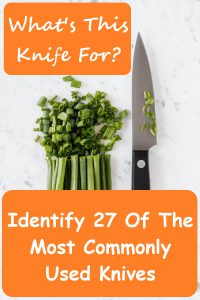
Knife with a short blade about 2 ½-4 inches long that is ideal for peeling round fruit and vegetables, also good for creating garnishes
Knife with a short rigid and slightly curved blade that has a straight extremely sharp edge used to peel potatoes and fruits
This knife is similar to a chefs knife but shorter and is used when your cut requires more delicate or precision work for chopping and slicing
A rounded knife with sharp serrated edges specifically built for slicing tomatoes without crashing them
Knife Sharpening
If you find that you are using the right kind of knife, and your problem is that your knife needs to be sharpened, do not fear. Knife sharpening is not a skill that only the most experienced chefs can handle, anyone can do knife sharpening. However, you should know it is particularly challenging to sharpen some very specific knives like steak knives and the decorating knife. This is because of the grooves on the side of the blade. So, if you have a knife with grooves on the side of the blade consider reaching out to a local expert blade sharpener.
There are many different ways to sharpen a knife, I have two methods that I prefer. The first being, the Rod. The rod is my go to choice for knife sharpening because it is small and easy to store, and easier to control. When using a rod sharpener you start at the heel of the blade and drag the knife blade across the rod all the way up to the tip of your blade. Once you drag one side of the blade across the rod, place the heel of the knife on the backside of the rod and drag again to sharpen both edges of your blade evenly.
As you drag try to keep consistent pressure along all parts of the blade. The better control that I mentioned earlier is being able to visually see the difference the sharpener is making on your blade as you sharpen the knife. If you are nervous about using a rod to sharpen your knives there are also electrical knife sharpeners that you can use.
The electrical sharpener has to be plugged in, and has a slit that you drag your knife blade through. Inside the slit are flexible abrasive discs that provide a gentle and quiet sharpening experience. You have to be careful as you use an electrical sharpener to ensure you apply equal pressure as you drag your knife blade through the slit. The steady pressure you apply will result in equivalent sharpening of all parts and sides of the blade.
One common misconception about electrical sharpeners is that it only takes seconds to sharpen a blade. Although an electrical sharpener sharpens both sides of your blade simultaneously it still takes minutes for an electrical sharpener to sharpen your blade. If you are not sure whether you will prefer a rod or electrical knife sharpener I recommend purchasing a cheap version of both, both being less than $25.00. Then you can use them both over a year or two to decide which one you prefer and invest in a nice one of your preferred choice down the road.
One other note about knife sharpening is you can invest in a pair of cut resistant gloves to help prevent injuries when knife sharpening. Below is the pair that I like to use.
So if you have been struggling in your kitchen with knives, stop throwing them away and buying new knives every couple of months, and invest in a knife sharpener today.
Knife Storage
Preventing Your Knives From Becoming Prematurely Dull
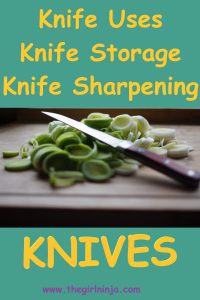
The number 1 way knives become dull is by rubbing up against other items. Knives can very easily get banged up against other knives or kitchen utensils or dishes. When your knife’s blade comes in contact with other items it dulls the knife’s blade. So, it is best to minimize any contact the knife has with anything other than what it is cutting. To minimize dulling your knife prematurely, best practices for caring for knives include the following:
– Don’t soak knives
– Rinse knives when done with them
– Wash and dry your knife immediately after use
– Store knives in a way that minimizes contact with the blade rubbing against other items
There are many knife storage solutions. My preferred storage solution is the magnetic block that hangs on our wall and knifes can be hung from. If you set your knife against this block and pull it away from the block as opposed to sliding, it prevents any dulling of the blade as a result of storage. If for any reason you are uncomfortable with knives hanging from your wall there are of course other options. Of course you can purchase a set that comes in the storage block or shown below after the wall magnet is a drawer organizer that keeps your knives separate from each other. The knife drawer organize also protects your knives from other items in your drawer.
For other posts about caring for your home such as organizing or managing clutter as well as keeping house and cleaning check out The Girl Ninja’s Everything At Home category on The Girl Ninja.
